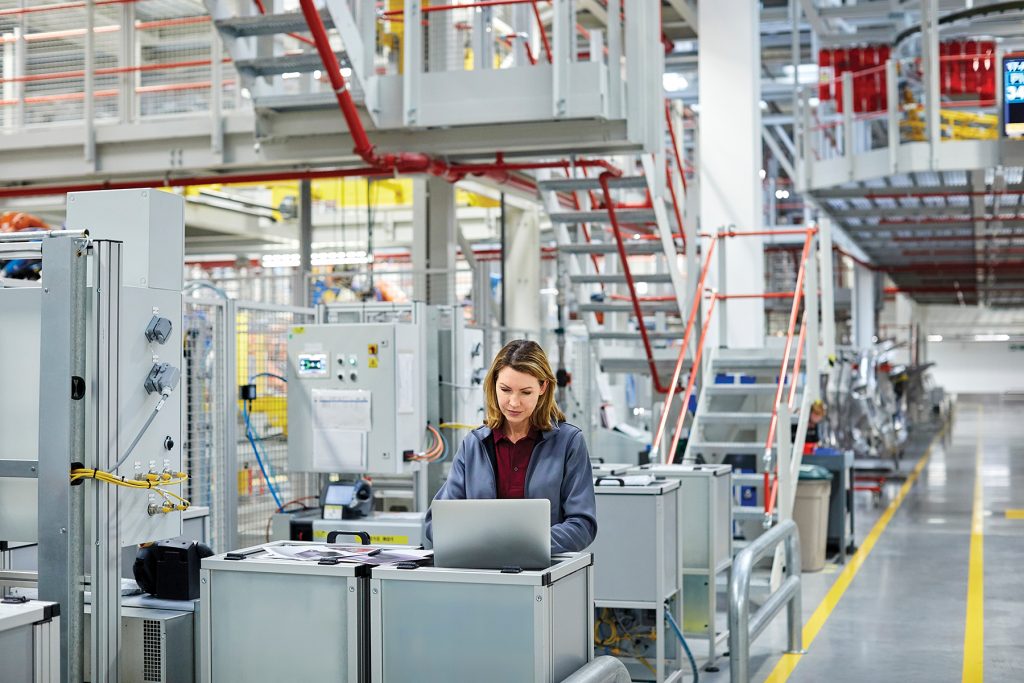
Top 5 industrial automation trends in 2020: Adrian Lloyd, Interact Analysis
January 14, 2020
By Adrian Lloyd
 Photo: Morsa Images/Getty
Photo: Morsa Images/Getty In the upcoming issue of Manufacturing AUTOMATION, we asked several industry experts to share their top five trends in industrial automation for the coming year.
It’s a new decade – read on for what Adrian Lloyd at Interact Analysis says manufacturers should expect in 2020. Looking for more insights? Read the top 5 trends from ARC Vice-President Craig Resnick, A3 President Jeff Burnstein, and ISA President Eric Cosman.
Adrian Lloyd, Interact Analysis
Adrian Lloyd is the CEO of Interact Analysis and has been involved in technology market intelligence for more than 20 years. As part of the leadership team at IMS Research, an information provider acquired by IHS Markit in 2012, Lloyd led research practices on a wide range of topics from industrial automation to semiconductors. Subsequently, he spent close to five years as senior director of research operations for IHS Markit’s technology, media and telecom business line, with responsibility for developing its broader strategy and acquisition focus.
1. The rise of simulation in manufacturing
Simulation is the best response to relentless market pressures in the manufacturing industry, the drive to improve quality and the increasing need for flexibility. At the design stage, modelling and simulation reduce costs by cutting out the need for physical prototypes and testing.
Test equipment can be expensive, both to purchase and operate, and can have a large footprint, using up factory space that could be put to more productive use, and increasing outlay on factory building leases. In an industrial market where technological advances and consumer demand continue apace, every day counts.
Volvo says that simulated testing of the XC60’s vehicle dynamics has reduced the process from days to hours. But this cutting-edge virtual approach is applicable to many areas of manufacturing, such as automated production-line development.
In Thailand, automotive start-up VinFast recently worked with Siemens to use simulation in factory automation, simulating factory layout and operation to optimize efficiency and productivity before the factory had even been built; and saving vast amounts of money in the process compared to traditional techniques.
2. Motor drives become the frontlines of IIoT and predictive maintenance
Arguably the most critical pieces of infrastructure in a plant are its rotating devices, and increasingly we are seeing efforts to place sensors and measurement devices on industrial motors to communicate status information.
These “smart sensors” allow information to be communicated about the motor, bearing block, fan or compressor that they are attached to, and point to a future where advanced software algorithms can predict motor failure well before it actually happens – “predictive maintenance.”
While much work needs to be done before we arrive at that place, one area of development that could support this wider effort is in the field of motor drives. Motor drives, generally speaking, are highly advanced pieces of equipment that one could argue are perhaps even over-engineered for the role they are doing. High-end microprocessors are used to perform complex calculations to control the speed of the motor.
Most motor drives use a “sensorless” control strategy, which is a bit of a misnomer as in reality, voltage/current sensors are used to perform measurements on the motor inputs. But in this context, “sensorless” means without the use of an encoder or resolver, and it is a generally accepted term for the market.
That being said, the fact that these sensors reside in the drive means that they can be used to model the condition status information of the motor. It has been reported that as much of 80 per cent of failure conditions for a typical motor can be monitored through the drive.
Thus, a clear opportunity for drives vendors, and one that we have already observed evidence of, is to use the drive to support condition monitoring and, in future, predictive maintenance.
3. Cobots come of age in manufacturing
Collaborative robots have emerged as a new and fast-growing technology that can satisfy the demand for automation and flexibility in manufacturing. They have the potential to reduce labour costs, assist workers doing tedious tasks, and improve workplace safety.
In 2018, global revenues from cobots exceeded $550 million. This was almost a 60 per cent increase over 2017. Over 19,000 cobots were shipped.
We forecast that revenues for cobots will continue to rise exponentially and that cobots with less than five-kilogram payloads and those with five- to nine-kilogram payloads – popular in small to medium-sized industrial settings – will play a major part in this growth.
Material handling, assembly and pick and place will be the three biggest applications of collaborative robots. But the use of cobots in small manufacturing operations that have historically not been able to afford or manage robots will pay a significant and growing role.
4. Strong growth in motion control
In spite of a small decline in 2019, the market for motion control products will outpace the growth of global manufacturing production from 2020 onwards. The sectors driving this more positive outlook are food and beverage machinery, robotics, packaging machinery and material handling equipment.
Together these sectors generated just under a quarter of total motion control revenues in 2018, and this share is set to rise through 2020, reaching 30 per cent by 2023.
Shifts in consumer buying habits leading to greater personalization and customization of products are driving demand for faster and more flexible production lines. This is, in turn, driving demand for motion control products.
The need to create a wider range of products in lower volumes is met by modifying motion control equipment through the addition of extra servo axes, thereby enhancing flexibility.
On a more general level, the establishment of industrial robotics and automation assures the place of motion control equipment in the warehouse environment.
5. Edge computing will have a major impact in manufacturing
The increasing number of IIoT devices has put considerable pressure on data centres (the cloud) and network bandwidths. This has resulted in slower transfer rates and response times – critical elements in many industrial applications.
Edge computing offers a solution to this problem. Autonomous vehicles are a good example of the importance of edge computing. In eight hours of driving, an autonomous car can generate around 40TB of data. Sending so much information to be processed by the cloud can be slow and impractical.
Better for edge computing, nearer the source of the data, to process the information with optimum speed, and ensure the safety of passengers and pedestrians. As edge computing matures in other sectors, so it will become more important in industrial scenarios.
The ever-increasing ability of small technical industrial devices to contain huge computational capacity makes edge computing more and more attractive in the industrial sector, enhancing work in remote locations where there is low connectivity and possibly low bandwidth; as well as in situations where rapid data analysis is required.
Advertisement
- B&R Automation adds machine switch for OPC UA over TSN communication
- Amada Miyachi announces support for linear DC resistance spot welding power supplies
